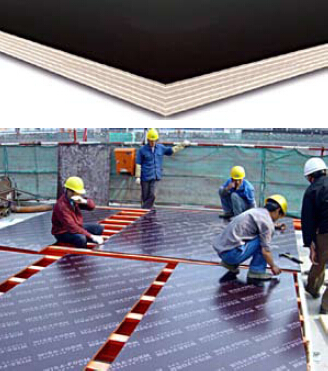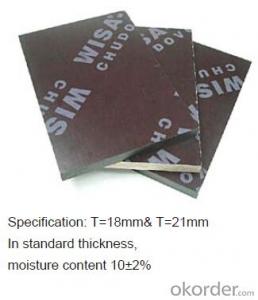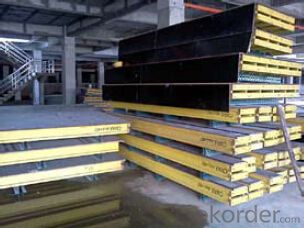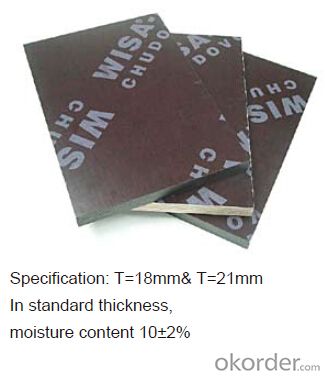Plywood formwork systems for formwork and scaffolding
- Loading Port:
- Tianjin
- Payment Terms:
- TT OR LC
- Min Order Qty:
- 50 m²
- Supply Capability:
- 1000 m²/month
OKorder Service Pledge
Quality Product, Order Online Tracking, Timely Delivery
OKorder Financial Service
Credit Rating, Credit Services, Credit Purchasing
You Might Also Like
Plywood --- make perfect concrete surface
WISA-Form Birch is a coated special plywood using in the formwork systems where high
requirements are set on the concrete surface and the times of reuses.
With CNBM timber beam & WISA plywood, the formwork is low weight but high load capacity, it is
widely used in construction.
Characteristics:
◆ Component with high standardization.
◆ Assembling in site, flexible application.
◆ Light weight, easy transportation and storage.


- Q: Can steel formwork be used for dam construction?
- Yes, steel formwork can be used for dam construction. Steel formwork is a versatile and durable option that is commonly used in various construction projects, including dams. It offers several advantages such as high strength, rigidity, and the ability to withstand the immense pressure and weight of concrete used in dam construction. Steel formwork can be easily assembled and disassembled, allowing for efficient and quick construction. Additionally, it provides a smooth and uniform finish to the concrete, ensuring the structural integrity and longevity of the dam.
- Q: How does steel formwork handle formwork stripping and cleaning?
- Steel formwork handles formwork stripping and cleaning efficiently due to its durability and strength. It can withstand the pressure and force exerted during the stripping process without getting damaged. Additionally, steel formwork is easy to clean as it has a smooth surface, allowing for quick and thorough removal of any residual concrete or dirt. Its robust nature and low maintenance requirements make it a preferred choice for formwork stripping and cleaning in construction projects.
- Q: Can steel formwork be used for bridge construction projects?
- Bridge construction projects can indeed utilize steel formwork. This versatile and durable solution is often favored for its high strength and ability to bear heavy loads. Steel formwork establishes a strong framework capable of withstanding the weight and pressure exerted by concrete during construction. There are several advantages to using steel formwork for bridge construction. Firstly, it can be easily customized and fabricated to achieve the desired shape and size, ensuring precise and efficient construction. Additionally, steel formwork can be reused multiple times, making it a cost-effective option for bridge projects. Moreover, the use of steel formwork guarantees a smooth and even finish on the bridge structure, resulting in a high-quality end product. Steel formwork also allows for the incorporation of various features, such as recesses and openings, which are often crucial in bridge construction. In conclusion, steel formwork is a suitable choice for bridge construction due to its strength, durability, and ability to provide precise and uniform finishes.
- Q: What are the safety considerations when using steel formwork?
- When using steel formwork, there are several safety considerations that need to be taken into account. Firstly, it is important to ensure that the formwork is properly installed and secured to prevent any collapses or accidents. Regular inspections should be conducted to check for any signs of wear or damage that could compromise its stability. Another safety consideration is the proper handling and storage of steel formwork. It can be heavy and cumbersome, so workers should be trained in proper lifting techniques to avoid strains or injuries. Adequate storage facilities should be provided to prevent any damage or tripping hazards. Additionally, when working with steel formwork, workers should wear appropriate personal protective equipment (PPE) such as helmets, gloves, and safety boots to protect themselves from any potential hazards or falling debris. They should also be trained in safe work practices, including proper use of tools and equipment, as well as the correct procedures for dismantling the formwork after use. Overall, by following these safety considerations, the risks associated with using steel formwork can be minimized, ensuring a safe working environment for all involved.
- Q: How does steel formwork affect the overall cost of a construction project?
- Steel formwork can increase the overall cost of a construction project due to its higher initial cost compared to other formwork materials such as wood or aluminum. However, steel formwork can be reused multiple times, resulting in lower long-term costs and faster construction timelines. Additionally, steel formwork offers better durability, strength, and stability, which can lead to improved quality and reduced maintenance expenses in the long run.
- Q: Are there any safety concerns associated with steel formwork?
- Yes, there are some safety concerns associated with steel formwork. One of the main concerns is the weight of the steel panels. Steel formwork panels can be quite heavy, which can pose a risk to workers during the installation and removal process. It is important for workers to follow proper lifting techniques and use equipment such as cranes or forklifts to handle the panels safely. Another safety concern is the risk of falls. Steel formwork is often used for constructing high-rise buildings, and workers may need to work at elevated heights. It is crucial to have proper fall protection measures in place, such as guardrails, safety nets, or personal fall arrest systems, to prevent accidents. Additionally, steel formwork may have sharp edges or protruding parts that can cause injuries if not handled carefully. Workers should be trained on how to handle and assemble the formwork properly to minimize the risk of cuts, bruises, or other injuries. Furthermore, steel formwork may require welding or cutting during its installation or modification. This can introduce hazards such as sparks, fumes, or fire risks. Adequate ventilation, proper personal protective equipment, and adherence to safe welding practices are essential to mitigate these risks. Lastly, there may be electrical hazards associated with steel formwork, particularly if it comes into contact with overhead power lines or if electrical tools and equipment are used nearby. It is important to identify potential electrical hazards and take appropriate measures, such as isolating power sources and implementing safe work practices, to prevent electrical accidents. Overall, while steel formwork offers various advantages in construction projects, it is crucial to be aware of these safety concerns and take necessary precautions to ensure the well-being of workers and prevent accidents on the worksite.
- Q: Can steel formwork be used for architectural construction projects?
- Yes, steel formwork can be used for architectural construction projects. Steel formwork is a versatile and durable construction material that is commonly used in architectural projects. It offers numerous advantages such as high strength, stability, and reusability. Steel formwork is capable of withstanding high pressure and can provide a smooth and precise finish to concrete structures. Additionally, it is resistant to warping, bending, and shrinking, ensuring the structural integrity of the construction. Steel formwork can be customized to fit any shape or size, allowing architects to create unique and complex designs. Due to its strength and durability, steel formwork can be used repeatedly, making it a cost-effective option for construction projects. Overall, steel formwork is a reliable and efficient choice for architectural construction projects.
- Q: Are there any specific considerations for using steel formwork in areas with limited space?
- Yes, there are a few specific considerations when using steel formwork in areas with limited space. Firstly, the dimensions of the steel formwork need to be carefully planned to ensure it can fit within the confined space. Additionally, the assembly and disassembly process should be efficient and require minimal space. It is also important to consider the weight of the steel formwork and ensure that it can be safely maneuvered within the limited space. Lastly, proper coordination with other construction activities and equipment is necessary to avoid any clashes or hindrances in the limited space.
- Q: What is the 86 series steel formwork
- If a large concrete pouring for the interruption or delay the closing fast and easy net is a kind of ideal material, it is a kind of preparation activities can form any emergency terminated required. The construction can be quickly restored, without dismantling work for temporary sealing end. Because of the use of quick and easy closing network can quickly build not included in the plan terminated, as a contingency measure. Customers can before large casting at the site to prepare some available will be attached, with concrete formwork for pouring the easy days after creating the ideal surface cementation.
- Q: Can steel formwork be used for sports complex construction projects?
- Sports complex construction projects can indeed utilize steel formwork. When it comes to shaping and building the necessary structures for such complexes, steel formwork proves to be a versatile and durable option. Its application extends to constructing walls, columns, beams, and slabs within the complex. Steel formwork possesses the strength and stability required for larger spans and higher load-bearing capacities, qualities often necessary for sports facilities. Moreover, the use of steel formwork yields a smooth finish, contributing to a professional and visually appealing appearance. In conclusion, steel formwork stands as a suitable choice for sports complex construction projects due to its strength, flexibility, and ability to efficiently create complex structures.
Send your message to us
Plywood formwork systems for formwork and scaffolding
- Loading Port:
- Tianjin
- Payment Terms:
- TT OR LC
- Min Order Qty:
- 50 m²
- Supply Capability:
- 1000 m²/month
OKorder Service Pledge
Quality Product, Order Online Tracking, Timely Delivery
OKorder Financial Service
Credit Rating, Credit Services, Credit Purchasing
Similar products
Hot products
Hot Searches
Related keywords

















